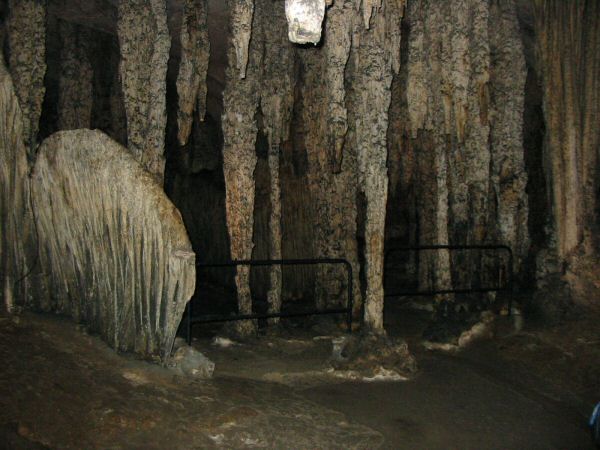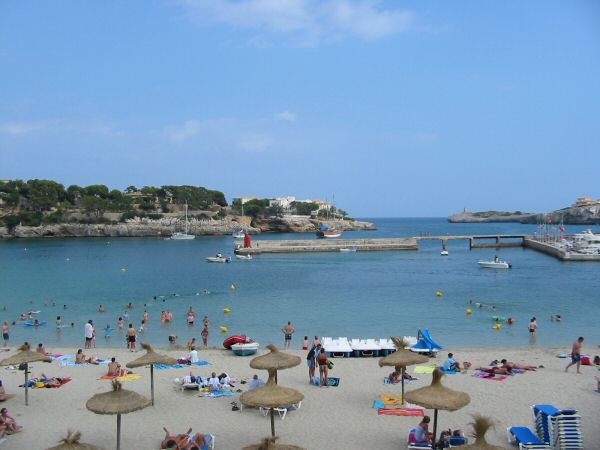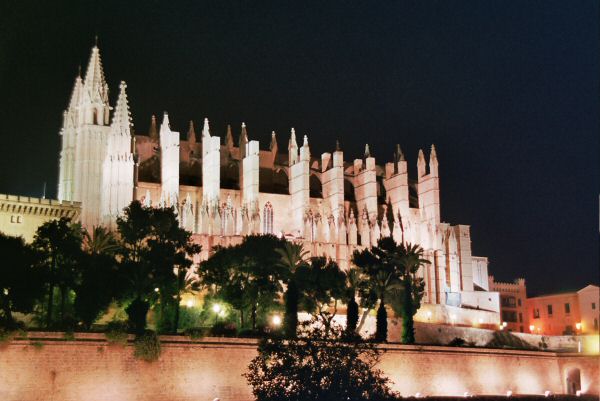Travel to Majorca
Day 2 Palma - Artà and Drach caves - Barcelona (166 Km.)
(in 80 Km.) Artà caves: The Artà caves are located in the seacoast of the municipality of Arta, in Cap Vermell, surrounded by mountains that rise above the sea. Have been visited since ancient times and is very likely to know the primitive inhabitants of the island and the various peoples who lived then. After the tall entry, you reach the so-called lobby or Entrance Hall, in which innumerable stalactites of prodigious shapes and extraordinary proportions hanging from a high dome. From there you access to the Queen of the columns, high stalactite of 22 meters in height. Then we go to Hell, which provides a sound and light show about 3 minutes. From Hell we pass to the Purgatory, after visiting the hall of the Theater and the organ, we arrived at the hall of flags, where the guide struck three columns giving each one a different tone. We visited The Elephant and going toward the exit pass by the "stones of Diamonds" that due to its base contents of carbon seems gems.

Artà caves
(in 22 Km.) Drach caves (Coves del Drach): The rigorous and scientific exploration of the caves dates from 1896 and is due to the Archduke Luis Salvador of Habsburg-Lorraine who commissioned the work to photoler Eduardo Martel. They consist of four caves linked together: the cave of the French, that of Luis Salvador, the White and Black cave. Are formed by the sea (the sea still continues its penetration) and are believed to be from the Miocene period. They consist of four caves linked together: the cave of the French, that of Luis Salvador, the White and Black cave. Are formed by the sea (the sea still continues its penetration) and are believed to be from the Miocene period. Very suggestive in this fantastic and petrified world is Lake Martel, whose waters are crossed by three illuminated boats and occupied by a few musicians who play for the visitors romantic melodies. The Theater of fairy and the Bathroom of Venus are some of the most spectacular corners.

Porto Cristo
(in 1 Km.) Porto Cristo: This small fishing village has kept its charm through generations. Yacht Club its surrounding by small cafes, craft shops and small hotels full of character. Its main attraction are the mentioned caves of Drach. They also are the Caves of Hams, which offer visitors the chance to see some prehistoric shellfish that remain outside of the evolution of species. In Porto Cristo can also visit the Aquarium of Majorca, next to the Caves of Drac, with Mediterranean flora and fauna and the Jumaica Tropical Park, with tropical gardens and exotic birds.

Palma bay
(in 63 Km.) Palma of Majorca: La Ciutat, as they call the Mallorcan, presents an impressive since it is close to the port. Adorned with yachts, palm trees and the cathedral in the background, provides a magical vision, whether it is even more impressive in the early hours of the morning. The Cathedral, known as "la Seo" by Majorcan is perhaps the most distinctive sign of Palma. Built between the fourteenth and nineteenth centuries had the honor of having during its reconstruction the creative talent of Gaudí, who was charged with rebuilding the interior. Emphasize the Puerta del Mirador, which opens up a stone wall in the sea. It was designed by the distinguished architect Guillen Sagrera, also the architect of La Lonja. In its interior the Royal Chapel, Chapel of the Holy Trinity and the Cathedral Museum, which houses a large number of Baroque works, among others. The Almudaina is the Royal Palace which was built on the home vanished musulman Alcazar and was the former residence of the Majorcan kings. La Lonja is perhaps one of the most beautiful examples of Gothic civil in the Mediterranean area. Today houses the Fine Arts Museum. It was built by Guillem Sagrera who gave a fantastic interior and a beautiful facade. The Consulate of the Sea holds within it a beautiful gallery of Renaissance, from the seventeenth century. The Paseo del Borne is the nerve center and heart of the old town, is one of the liveliest streets of the city. On this walk, and right to the left brings medieval streets decorated palaces and elegant homes of the nineteenth century. The large number of palaces of the seventeenth and eighteenth centuries who owns Palma is perhaps one of the most attractive aspects of his tour.

Palma Cathedral
The stretch between the cathedral and the Plaza de Cort returns to us as the palaces of Colom, of the Villalonga, Oleo, Truyols and the Oleza. Also near here we find the Archbishop´s Palace, the Church of San Francisco and the Arab Baths, the latter can be counted among the few remnants of what was the city in time of Muslim domination. In the Plaza de Cort is the City Hall, with its beautiful facade of the seventeenth century and its distinctive and original roof. Nearby, are worth visiting the Church of Santa Catalina, in Gothic style. The Puig de Sant Pere district is located on the other side of the Paseo del Borne, behind the Lonja. It highlights the Church of Santa Cruz, built in the fourteenth century on a crypt of the s. XIII; Weyler House, the House Belloto and the Palace of Montenegro. Bellver Castle is located on the outskirts of the historic center. It was built by Pere Salvá on a hill, overlooking an extraordinary panorama. This presents a Gothic elegance, something rare in a defensive fortress, however, without losing the functionality for which it was built.